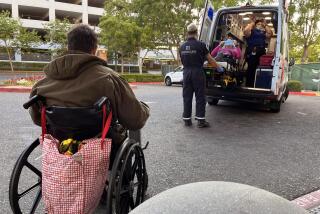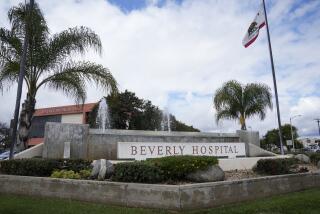Emergency Room Losses Mount
- Share via
California emergency rooms lost $325 million in the 1999-2000 fiscal year, nearly $9 million more than the previous year, according to a report released Tuesday by the California Medical Assn.
To cope with the financial losses, hospitals throughout the state have cut back staffing and beds in emergency rooms and regular wards.
In Los Angeles County, where emergency rooms lost $98 million in 1999-2000, a quarter of the hospital emergency rooms are so strapped for resources that last month they were closed to new patients more than 30% of the time, the county’s chief of emergency medical services said Tuesday.
County records show seven emergency rooms--including those at major public hospitals, Martin Luther King Jr./Drew, County-USC, and Harbor/UCLA medical centers--were closed to new patients more than half the time in October. The others were Lancaster Community Hospital, California Medical Center, Northridge Hospital Medical Center/Roscoe Boulevard Campus and Midway Hospital Medical Center.
Those statistics are all the more worrisome, experts said, because October was not an extraordinary month. The stress of a bioterrorist attack--let alone a harsh flu season--could easily overwhelm the system, they said.
“When hospitals are running at 100% capacity on a daily basis, you could only speculate at what would happen if something” worse took place, said Dr. Joel Geiderman, co-chairman of emergency medical care at Cedars-Sinai Medical Center. “Whether it’s a national disaster, a terrorist thing or just a bad flu season, I don’t know what we’re going to do.”
As it stands, paramedics have taken to waiting--sometimes for hours--in loading bays and hallways with patients for whom there is no room at nearby hospitals.
“The protocol is to go to the next closest hospital that is not on diversion,” which means it is open to new patients, said Virginia Hastings, chief of emergency services for Los Angeles County. “The reality is that there are so many hospitals on diversion that there’s no place left to go.”
Doctors say that puts lives in jeopardy. “We’re having a lot of near-misses,” said Dr. Brian Johnston, an emergency room doctor who serves on the state medical association’s board of trustees. “There are going to be cases where the person dies.”
Some of the region’s biggest hospitals spent hundreds of hours in October closed to new patients, Hastings said. Most often closed was King/Drew Medical Center, which diverted patients 67% of the time in October. Lancaster closed its emergency room 60% of the time. California Medical Center in Los Angeles was closed 58% of the time, as was County-USC Medical Center, the West’s largest public hospital.
Diversions have plagued the emergency system in Los Angeles County for years, but they have increased significantly of late, Hastings said. Several emergency rooms have permanently closed, and in some areas, those that remain are few and far between.
In the Antelope Valley, there are just two emergency rooms to serve the entire populations of Palmdale and Lancaster--230,000--and both are frequently closed, said Mike Metro, acting assistant fire chief for Los Angeles County.
It can take hours to be seen during the flu season at Antelope Valley Hospital, which handles 75,000 patients in its emergency room each year, said Linda Lawson, assistant vice president for nursing.
The private hospital closed its emergency room 48% of the time during October, according to county statistics.
When the emergency room is closed, patients frequently have no choice but to wait, Lawson said. There is no public hospital with an emergency room nearby where overflow patients can be sent. The emergency room at Lancaster Community Hospital, which is much smaller, is also frequently closed, and the closest emergency room, in Santa Clarita, is 40 miles away.
Throughout the county, so many paramedics have to wait with patients in overcrowded emergency rooms that the Fire Department has been forced to bring on reserve squads to cover fires and other emergencies, Metro said.
During the last flu season, a patient at Cedars-Sinai waited 24 hours for a bed, Geiderman said.
“It’s depressing,” said Geiderman, who likens the situation to that of California’s too-small power grid.
In Los Angeles County, the steepest financial losses in 1999-2000 were at County-USC Medical Center. The giant Eastside public hospital lost $53 for every emergency room patient, for a total of more than $11 million.
King/Drew Medical Center lost $10.7 million, at a rate of $180 per patient. Childrens Hospital Los Angeles lost $3.5 million, and Citrus Valley Medical Center in West Covina lost $3.4 million.
The troubles have been building for nearly two decades, as more people have become uninsured and payments by health plans and the government to hospitals and doctors have been reduced.
That puts pressure on hospitals like Northridge Hospital Medical Center, which county records show was closed 54% of the time last month. A third of the 27,000 people who came to the emergency room last year were on Medi-Cal or Medicare, and 12% were uninsured.
Payment for the uninsured, doctors and administrators say, does not always cover the cost of care.
Ten emergency rooms were closed entirely in 1999 and 2000, according to the California Medical Assn. Public health officials do not have the power to order hospitals to keep them open or to order new hospitals to be built.
“This is a market-based system,” said Lea Brooks, spokeswoman for the California Department of Health Services.
And as long as operating an emergency room is a money-losing proposition, she and others said, new ones are not likely to be built.
More to Read
Sign up for Essential California
The most important California stories and recommendations in your inbox every morning.
You may occasionally receive promotional content from the Los Angeles Times.













